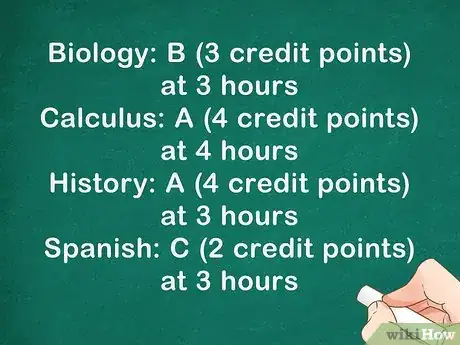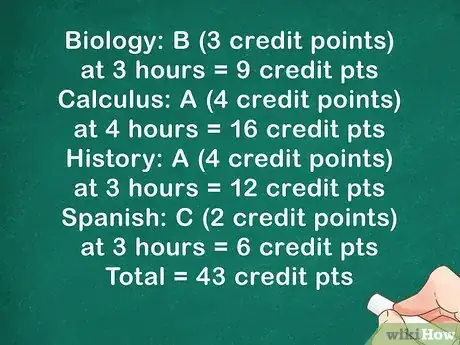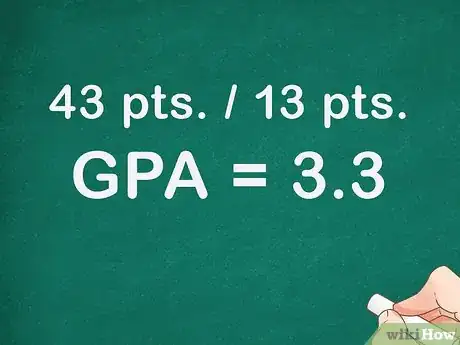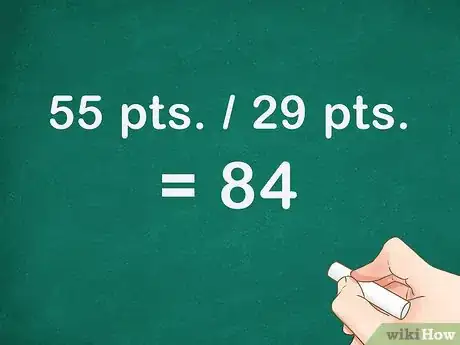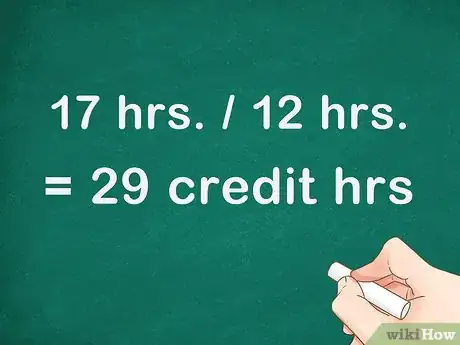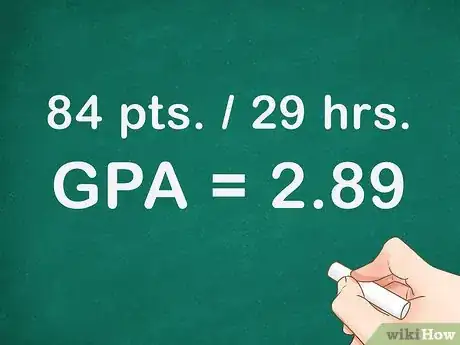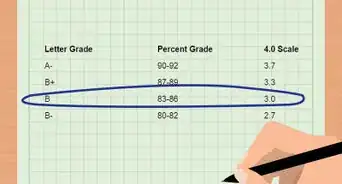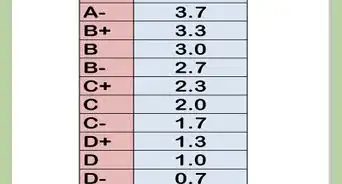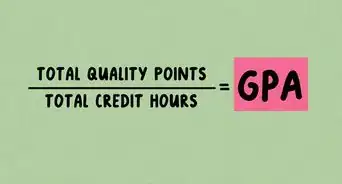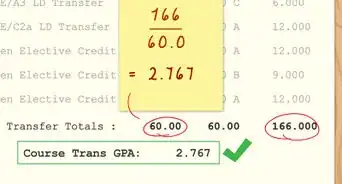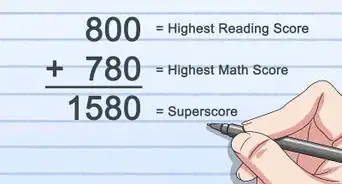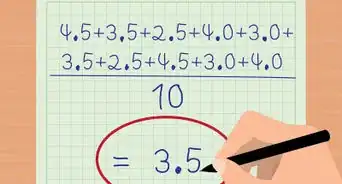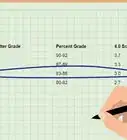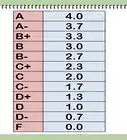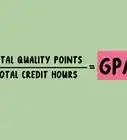X
This article was co-authored by Christopher Taylor, PhD and by wikiHow staff writer, Jessica Gibson. Christopher Taylor is an Adjunct Assistant Professor of English at Austin Community College in Texas. He received his PhD in English Literature and Medieval Studies from the University of Texas at Austin in 2014.
This article has been viewed 189,996 times.
In many ways, figuring out your college GPA (grade point average) is actually easier than figuring out your high school GPA. If you know your letter grades and credit hours (a unit of measurement to reflect your weekly time in the classroom), you should be able to find your GPA for a term. You can also use this information to calculate your overall college GPA.
Steps
Part 1
Part 1 of 2:
Calculating Your Semester GPA
-
1Write down your grades. Write down a list of what classes you took during the term. Next to each class, write down the grade you earned. Don't worry about writing down a percentage, just note the letter grade that you got. For example, your list may look something like this:
- Biology: B
- Calculus: A
- History: A
- Spanish: C
-
2Use a grading scale to note how many points each letter grade is worth. Use your school's grading scale to determine how many points each letter grade earns. The scale should be available from the registrar or the registrar’s website. Be sure to take into account any pluses or minuses, if applicable. These may or may not change the number of points assigned to each grade letter, depending on your school’s policy. For example, you'd build on your list like this:[1]
- Biology: B (3 points)
- Calculus: A (4 points)
- History: A (4 points)
- Spanish: C+ (2 points)
Advertisement -
3List how many credits each course is worth. Once you've made your list, look in your school's course catalog to determine how many credits each course is worth. Sometimes, seminars or labs may be worth fewer credits so it's important to calculate how many credits you took in a term. Write down how many credits each course is worth. For example, your list may now look something like this:[2]
- Biology: B (3 credit points) at 3 hours
- Calculus: A (4 credit points) at 4 hours
- History: A (4 credit points) at 3 hours
- Spanish: C (2 credit points) at 3 hours
-
4Determine how many grade points (credit points) you earned for your courses. For each course on your list, multiply the credit for your grade by the number of hours the course was worth. Once you've done this for each course, you can add up all of the grade points (credit points) to calculate your total grade points (credit points) for the term. Your list may look like this:
- Biology: B (3 credit points) at 3 hours = 9 credit points
- Calculus: A (4 credit points) at 4 hours = 16 credit points
- History: A (4 credit points) at 3 hours = 12 credit points
- Spanish: C (2 credit points) at 3 hours = 6 credit points
- Total = 43 credit points
-
5Determine your semester GPA by dividing credit points by coursework hours. Take your total credit points and divide this number by the number of credit hours you took. Remember not to count any classes you withdrew from.[3]
- For example, you would divide 43 (credit points) by 13 (credit hours) to get a weighted GPA of 3.3.
Advertisement
Part 2
Part 2 of 2:
Determining Your Overall GPA
-
1Add up your credit points. You can write down a list of all of your credit points, but it will probably be easiest to find this using your transcript. Write down the total credit points from each semester or term. These are sometimes called quality points. Add the points from every semester or term up to determine your total credit points.[4]
- For example, if you earned 55 credit points for your first term and 29 points for your second term, you would have a total of 84 credit (or quality) points.
-
2Calculate how many credits you took. Write down how many credit hours you took for every term or semester. Add these numbers together to get your total credit hours.[5]
- For example, if you earned 17 credit hours for your first term and 12 credit hours for your second term, you would have a total of 29 credit hours.
-
3Calculate your overall or cumulative GPA. Take your total credit points and divide this number by your total credit hours. This will average out your grade points for every semester and term you included.[6]
- For example, take 84 (your total credit points) divided by 29 (total credit hours) to get a 2.89 cumulative GPA.
Advertisement
Community Q&A
Did you know you can get expert answers for this article?
Unlock expert answers by supporting wikiHow
-
QuestionIs a 3.0 GPA good in college?
 Christopher Taylor, PhDChristopher Taylor is an Adjunct Assistant Professor of English at Austin Community College in Texas. He received his PhD in English Literature and Medieval Studies from the University of Texas at Austin in 2014.
Christopher Taylor, PhDChristopher Taylor is an Adjunct Assistant Professor of English at Austin Community College in Texas. He received his PhD in English Literature and Medieval Studies from the University of Texas at Austin in 2014.
English Professor
-
QuestionIs a GPA of 2.5 good?
 Christopher Taylor, PhDChristopher Taylor is an Adjunct Assistant Professor of English at Austin Community College in Texas. He received his PhD in English Literature and Medieval Studies from the University of Texas at Austin in 2014.
Christopher Taylor, PhDChristopher Taylor is an Adjunct Assistant Professor of English at Austin Community College in Texas. He received his PhD in English Literature and Medieval Studies from the University of Texas at Austin in 2014.
English Professor
-
QuestionHow do I calculate my cumulative GPA?
 Christopher Taylor, PhDChristopher Taylor is an Adjunct Assistant Professor of English at Austin Community College in Texas. He received his PhD in English Literature and Medieval Studies from the University of Texas at Austin in 2014.
Christopher Taylor, PhDChristopher Taylor is an Adjunct Assistant Professor of English at Austin Community College in Texas. He received his PhD in English Literature and Medieval Studies from the University of Texas at Austin in 2014.
English Professor
Advertisement
Things You'll Need
- Calculator
- Transcript (or an accurate memory of all grades received)
- Paper and pencil
References
- ↑ https://www.uc.edu/about/registrar/grades-and-transcripts/grade-changes/pass-option/gpa-calculator.html
- ↑ https://www.uc.edu/about/registrar/grades-and-transcripts/grade-changes/pass-option/gpa-calculator.html
- ↑ https://www.uc.edu/about/registrar/grades-and-transcripts/grade-changes/pass-option/gpa-calculator.html
- ↑ https://www.mtholyoke.edu/sites/default/files/registrar/docs/calculate_gpa.pdf
- ↑ https://www.mtholyoke.edu/sites/default/files/registrar/docs/calculate_gpa.pdf
- ↑ https://www.mtholyoke.edu/sites/default/files/registrar/docs/calculate_gpa.pdf
About This Article
Advertisement


